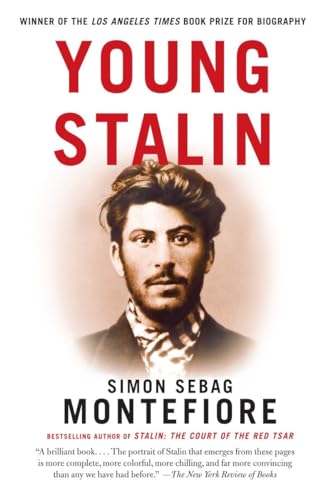Buckle up, folks! Today, I’m talking about the wild ride that is Young Stalin. This is not your boring old history class—oh no. This review will look at the chaos of Stalin’s early days, the parade of outrageous friends and enemies, and the punchy storytelling that somehow makes one of history’s scariest guys almost… entertaining. I’ll give you the good, the bad, and the weird, so you’ll know if this book is worth your lunch money. Spoiler: it made me double-check if any of my friends are secret revolutionaries.
In a nutsheel
Alright folks, here’s the scoop on Young Stalin. This book, written by Simon Sebag Montefiore, is biography meets action movie, plus some wild Russian history thrown in. You get a peek at the early years of the guy who’d eventually rule the Soviet Union with an iron fist—before all the scary mustache photos.
The book falls squarely into the non-fiction and biography genre, but if you like crime stories and political drama, it’ll scratch that itch too. Montefiore serves up secret bank heists, big betrayals, poetry (no, really), and plenty of dangerous friendships. Themes include survival, power, rebellion, and how weird childhoods can mess you up in creative ways. Don’t worry, I’m not spoiling anything—just saying, you’ll learn a lot and be entertained, unless you hate fun or Russia.
The Wild World of Young Stalin: Childhood Chaos and Strange Influences
Alright, let’s talk about the early days of Joseph Stalin, or as he was known back then, Ioseb Besarionis dze Jughashvili (I know, it sounds like you sneezed and tried to type your name). The book Young Stalin really digs up the dirt on his childhood in Gori, a small Georgian town. And let me tell you, it was anything but boring. Young Stalin didn’t come out of the womb twirling his mustache and plotting world domination. No, he started off as a scrawny, accident-prone kid who caught so many diseases, he probably had a punch card at the local doctor’s office.
His dad, Besarion, was a brawler and a boozer. Apparently, beating your kids was the only parenting manual in the house. Stalin’s mom, Keke, was tough, stubborn, and very ambitious. She wanted her boy to become a priest, which is hilarious if you know how that turned out. But you can see where young Stalin got his iron will. And the book shows us that Gori was a place where knife fights were a hobby, so being tough wasn’t really optional.
Here’s where it gets juicy: Stalin soaked up influences from all sorts of oddballs. There were poets, priests, and bandits everywhere. He read poetry, listened to folk legends, and watched revolutionaries sneak around. These early years set him up to be clever, crafty, and pretty ruthless. You start to think that maybe the mustache was just a way to cover up his bruises.
Next up, we go from schoolyard scraps to raising hell in the streets—stay tuned for Stalin’s wild political rise and his revolutionary mischief!
Young Stalin’s Political Rise and Revolutionary Activities
Let me tell you, if you think your side hustle is tough, try running from the secret police while printing illegal newspapers. Young Stalin, known as Soso back then, was basically a one-man wrecking ball in the world of Russian revolutionary politics. He didn’t just read about politics, he made it his whole personality. At a young age, he joined the Marxist underground, dodging tsarist spies like he was in a game of revolutionary hide-and-seek.
He helped build up the Bolshevik movement, proving he wasn’t just another angry guy with a beard. Stalin could organize strikes, stage protests, and somehow convince people to go along with his wild plans. He even robbed banks—yes, you read that right—to fund the revolution. His criminal resume would make your local neighborhood troublemaker blush. If the Bolsheviks needed money, Stalin would show up and say, “Give me a train schedule and a bag—trust me.”
The guy was so good at sneaking around that the police gave him the nickname ‘The Invisible Man’. He got arrested and escaped so much, you’d think he had a loyalty card at the Siberia hotel. The one thing he loved more than evading arrest was arguing with other revolutionaries. He had beef with Lenin, Trotsky, and pretty much anyone who dared cross him in a debate. That stubbornness and street smarts made him a heavyweight in the revolutionary world, long before he became the big boss of the Soviet Union.
Trust me, the people Stalin hung around with were even weirder than he was – and that’s where we’re headed next: his colorful cast of friends and foes!
The Wild Bunch: Friends and Foes Around Young Stalin
Let me tell you, the crowd young Stalin ran with could turn a calm tea party into a circus in under five minutes. In Young Stalin, Simon Sebag Montefiore sketches a world where friends and enemies swapped places quicker than a stray cat chasing a mouse. Some pals looked like they strolled off the set of a pirate film, complete with wild beards and even wilder ideas. His poetry buddy, Kote Tsintsadze, helped Stalin hide from the secret police. These guys would chat about poetry one minute and smuggle weapons the next. Not your average friendship, unless your average Saturday night includes dodging the law while writing love poems (I can’t say mine does, unless you count the time I hid from my neighbor to avoid mowing the lawn).
But for every comrade cheering him on, Stalin had a rival ready to toss him under the nearest horse-drawn cart. Some tried to outsmart him, others tried to out-punch him (spoiler: not many succeeded in either). Montefiore doesn’t just rattle off names—he paints them all as larger-than-life characters. It’s like reading the best cast list from a TV show, but the prize for winning isn’t a trophy, it’s survival. The cast around young Stalin makes the book feel almost like a soap opera, with more mustaches and sabotage.
Stick around, because next up I’ll be judging Montefiore’s writing skills and whether this story sprints, crawls, or does an awkward chicken dance!
How Does Montefiore Keep Young Stalin Moving?
The way Simon Sebag Montefiore tells Young Stalin is like listening to a guy in a bar who has the most wild stories, but always circles back to the point. His writing is punchy, never boring, and you never have to reread a sentence to figure out what the heck he just said. It’s like he grabbed my hand and yanked me through Stalin’s wild youth at top speed. The story never drags. Montefiore bounces from one incident to another, giving us just enough detail so I get the picture, but not so much that my eyes glaze over. Honestly, I wish my history teachers learned from this guy.
What I enjoyed most is that the book jumps between juicy secret files, wild letters, and even police reports. It feels part-mystery, part-action movie, and sometimes part-comedy (seriously, I laughed out loud at some of Stalin’s early misadventures). The pacing is just right for people who get distracted easily. You won’t find any twenty-page descriptions of a tree here—Montefiore keeps things crisp and moving.
But, if you want all the tiny historical details down to what kind of socks Stalin wore, you’ll feel a bit let down. Montefiore trades some academic detail for story zip. Me? I didn’t mind, but I guess if you’re a history nerd who loves endless footnotes, you might. Still, this book is more fun than a barrel of Bolsheviks (which is probably not that fun, honestly).
If you want a history book you’ll actually finish, I say go for Young Stalin. I would totally recommend it for anyone who likes action with their facts!
Conclusion
Alright, that’s a wrap for my review of Young Stalin. If you want to see how history gets wild (and frankly, a bit weird), this book has your back. Montefiore writes with energy, turning old Russian chaos into pure entertainment. Sure, sometimes the details zip by so fast you’ll feel like you missed the train, but you won’t be bored! If you like your history exciting and packed with colorful characters, give this one a shot. Unless you hate fun, then maybe not. Thanks for reading—I promise I didn’t get arrested while writing this.


